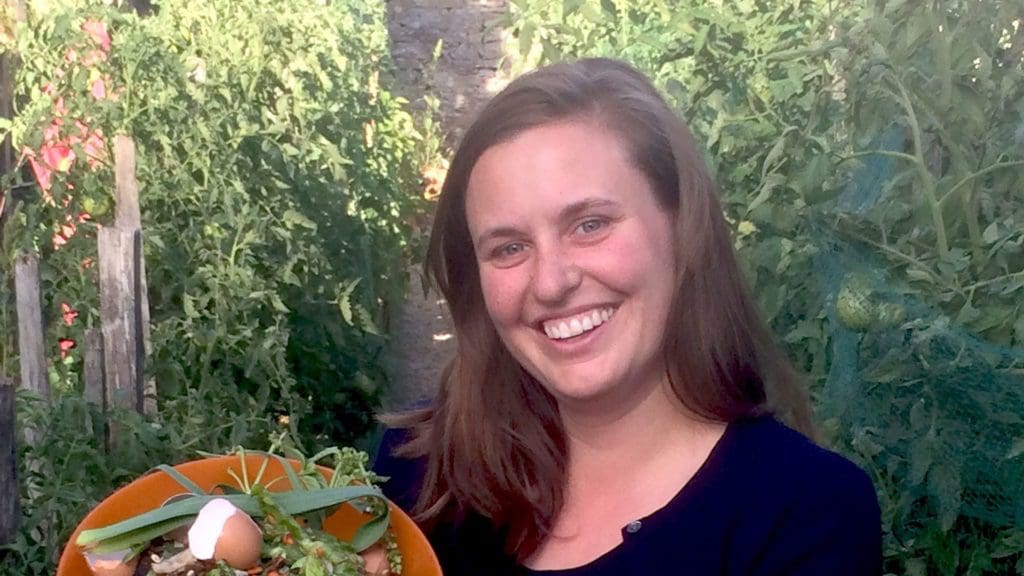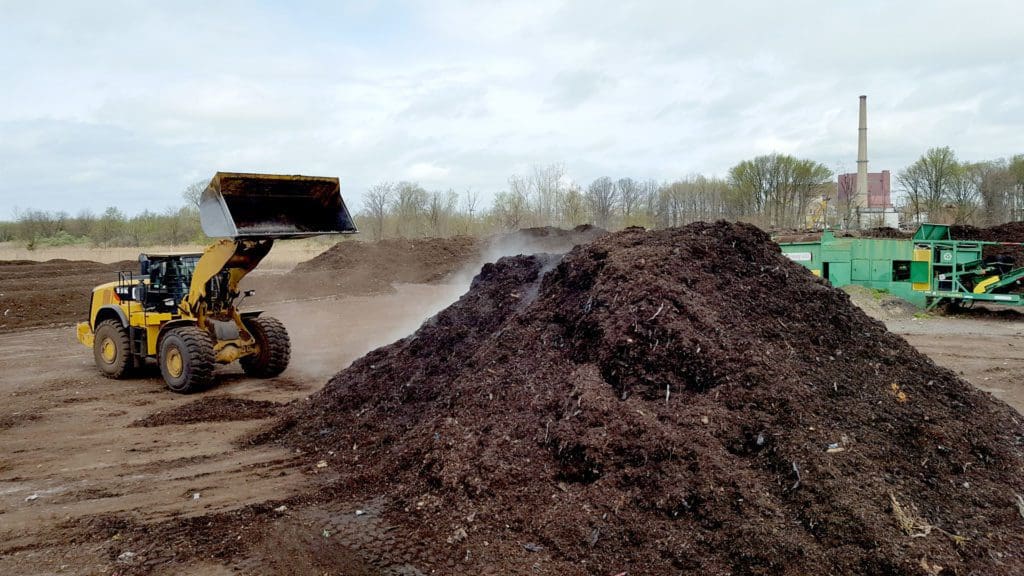Louise Bruce Empowers Communities Through Composting
We had the great pleasure of talking with NYC Department of Sanitation’s Senior Program Manager of NYC Organics — and all-around compost enthusiast — Louise Bruce about New York City’s composting initiatives. For years, Louise has shown her commitment to the idea that “in order to grow healthy communities and a strong food system, it is critical that we nourish our soils.” To do so, she has dedicated her work to implementing food waste composting and education on all scales, from beginning community-based composting projects to leading Big Reuse‘s compost team (formerly Build It Green!NYC) and now by implementing policy solutions for the City itself. Today, she oversees the development and expansion of New York City’s organic waste management programs, which strives to meet New York City’s goal of providing all New Yorkers with curbside collection bins and convenient drop-off locations to recycle their food waste. Louise has been listed on the University of California’s Global Food Initiative’s “30 Under 30” inspirational young people influencing the food system as well as GOOD’s “People Are Awesome” series. We couldn’t agree more.
You’ve been an active community composter since 2009 when most New Yorkers had not yet joined the food waste obsessed. What informed — and then inspired — you to start composting in New York City?
In 2009, I took the NYC Master Composter Course, a program funded by the NYC Department of Sanitation. There was an empty lot near my house and I became completely obsessed with the idea that it could be a ‘compost first’ garden. As I was also brand new to NYC and to my neighborhood, I didn’t have a connection to my community; this was my way of plugging in and getting involved.

In 2010, you turned a vacant lot in Kensington, Brooklyn into a community garden that emphasized composting. How did you get people interested and excited about food waste? Is the garden still going strong?
Yes, the garden is still going strong! The truth is, once we opened the gates, our neighbors came to us. I realized very quickly that the lot that was my obsession was also becoming my neighbors’ as well. For example, the very first day that I opened the gate and started digging in the soil – not that you could call it soil, it was more like debris and rubble — I noticed a woman in the building next door looking out her window. A few minutes later, her daughter came running down to the lot with a bottle of water and a full plate of home-cooked Pakistani food. She offered it to me and said, “My mother had a dream last night that this vacant lot would become a beautiful garden. Let us know what you need.” I was stunned. It’s actually making me quite nostalgic remembering it.
Once we were more established, we learned that healthy soils and healthy plants (thriving thanks to the food scrap compost) drew people in. There is no brochure or public service announcement that speaks to people like a flower or tree. We found that people would stop to gaze at a sunflower and then, once they learned what we were doing, would start getting involved in the composting piece.
As a food and compost lover (and one of the best community builders we’ve ever met) you are well versed in the connection of food and the environment. From your experience, what is the best way to advocate on behalf of localized food systems and to build community involvement?
Listen first. Find out where people are coming from, what role they want to play and how they want to be involved. Be unabashedly in love with what you do and are advocating for — enthusiasm is infectious. See opportunity in everyone: we need everyone’s skills, vision, effort and participation. Make yourself dispensable and share everything you know and all the connections you have. For things to become a movement and projects to live beyond you, they cannot depend on one person or a small group.
Since beginning a community garden, you have worked with BIG!Compost/Build It Green and are now with NYC’s Department of Sanitation (DSNY) working directly with the City to implement citywide composting. New York City has 8 million people and we eat and waste a lot of food here. How does the system work, especially in comparison to other municipal composting programs?
The NYC Department of Sanitation’s organics collection program is now the largest in the nation. We began implementing curbside collection of organic waste in 2013, and as of June 2017, two million residents citywide now have access to organics collection service. We’re on track to grow our organics initiatives to serve all New Yorkers by the end of 2018 with either curbside service or convenient neighborhood drop-off sites. We’re also expanding enrollment programs into high density neighborhoods with apartment buildings of ten units or more in Manhattan and the Bronx. And we’re continuing to grow our network of food scrap drop-off sites citywide — there are currently more than 100. We have drop-off sites conveniently located at commuter hubs, farmers markets, CSA pickup sites, libraries and other highly-trafficked areas.
How many tons of food scraps are you collecting and how do you think those numbers will change in the upcoming years?
In 2016, we collected approximately 23,000 tons of food waste and other organics. That number will grow significantly as we expand the program to serve all New Yorkers by next year. The Department collects 10,500 tons of trash every day and more than one third of this is wasted organics — food scraps and yard waste that could be put to good use.

Urban environments mostly keep food systems pretty well hidden from their citizens so city dwellers tend not to see where food is grown, processed and then disposed of. I imagine a lot of education and advocacy is going into generating understanding about what compost is, let alone what can be composted and why it’s necessary. How is the City engaging the public?
You are absolutely right! Waste systems are nearly invisible – you toss it to the curb and we take care of the rest. That’s why outreach and education is critical. One way that we are building public understanding and support for organics recycling is by supporting community composting initiatives throughout the city through our NYC Compost Project. Our teams work with over 200 volunteer-run community composting sites (just like Compost for Brooklyn) to engage New Yorkers in composting.
Additionally, as we roll out organics collection, we have outreach teams that do door-to-door outreach in many different languages, host pop-up information tables and care for street trees and public spaces with DSNY-made compost.
New York City, like all municipalities, has limited funds and resources. Composting takes labor, curbside bins, garbage trucks and anaerobic digesters. Is the administration prioritizing composting programs and do they think it will be cost efficient in the long term?
NYC is committed to building an effective and efficient organics collection program, while creating clean energy, healthy soil and green jobs. Zero waste to landfills by the year 2030 is a critical goal of the administration, outlined in OneNYC. DSNY’s goal is also to implement organics collection service without increasing the total number of trucks citywide. As the Department implements new organics service, we are also refining other routes to ensure efficiency.
What are the hurdles going to be moving forward?
I feel like the department under our new commissioner has just done an amazing job of making this happen and I don’t feel like there’s any challenge we can’t handle. Ultimately, the challenge is about getting residents to participate. We want to do everything we can to help facilitate that.
What is DSNY Organics working on and promoting right now?
Right now, I’m most excited about the NYC Food Waste Fair! This month, DSNY’s Foundation for New York’s Strongest will host the largest exhibition of food waste solutions. We’ll be supporting food waste solutions by equipping businesses with knowledge, tools and connections to prevent food waste. The fair will have educational workshops and an exhibit hall showcasing vendors.
In the futuristic fantasy of what the Food Waste Utopia will look like, how do you envision New York City looking and how close are we to getting there?
I don’t think it is a fantasy to believe that we can emulate the circular nature of a forest and build a NYC that uses 100 percent of its organic “waste” to feed people, animals and soils to create energy. We have lots to do, but it is a very practical, achievable goal. There is so much innovation happening around waste right now. We saw that at our Amuse-bouche/NYC Food Waste Fair preview last week, and it’s also why I co-founded Talk Trash City. I meet people every day who see resource and value — instead of trash — in our waste stream and who are taking enormous steps toward a waste-free circular economy.
Keep up with Louise and the NYC Department of Sanitation:
Twitter: @NYCsanitation and @NYCzerowaste
Instagram: @NYCsanitation and @NYCzerowaste
Facebook: New York City Department of Sanitation
More Reading
Can recycled soil blends support a more sustainable future?
September 5, 2025
How to make your kids’ school lunch more eco-friendly
August 19, 2025
Looking to jar up the season? Try a canning club
August 7, 2025
Gamify your family’s food waste reduction
June 30, 2025
Can food recyclers help us tackle household food waste?
June 18, 2025
Do organic waste bans and composting programs really take a bite out of food waste?
March 17, 2025
What is Europe getting right about food waste in schools?
November 15, 2024
Municipal composting has increased, but what does that really mean?
May 16, 2024
6 upcycled food trends to watch
February 13, 2024
Food scholar Darra Goldstein on the culinary history of preservation
October 30, 2023
